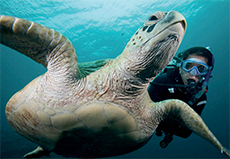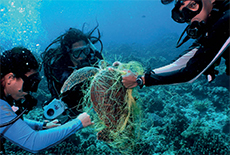




| Home | Features | Club Nights | Underwater Pics | Feedback | Non-Celebrity Diver | Events | 3 July 2025 |
| Blog | Archive | Medical FAQs | Competitions | Travel Offers | The Crew | Contact Us | MDC | LDC |

|

|
 
 |
  ISSUE 20 ARCHIVE - THE SEA DOC INVESTIGATES: TURTLESDr John CarlinI recently watched a clip on YouTube about the comedian Ricky Gervais who was asked to name his guilty pleasures which included songs (MMMBop by Hanson) and films (Pretty Woman).Now I am not going to name my musical guilty pleasures, all I am going to say is I have a very eclectic music taste and, to which my family, friends and work colleagues will attest to, one of my guilty cinematic pleasures is the children's animated film 'Finding Nemo'. One of my colleagues called AJ, who works for PADI out in Sydney, Australia had never seen the film, so I explained the plot to him and this is my favourite 'googled' version if you have never seen the film before: "A serial killer kills a man's wife and children. Just one child remains. Crippled by the attack. In a horrid twist of fate, the crippled child is kidnapped. The father embarks on a daring journey, assisted by a mentally disabled woman in the search for his son!" My favourite characters in the film are a turtle called Crush and his son called Squirt. In this edition of the 'The Sea Doctor investigates...' I am going to look at why sea turtles are so cool... ARE TURTLES, TERRAPINS AND TORTOISES THE SAME THING?The common names of turtle, terrapin and tortoise refer to differences in where the species live and how they live. Tortoises are the land-dwellers, don't have webbed feet and eat low growing shrubs and grasses. Terrapins spend time on land and in water, usually in the brackish waters of rivers, ponds and lakes. Turtles are the sea- dwellers, with most species rarely leaving the ocean. WHAT KIND OF TURTLE WAS CRUSH?The character Crush was based on a Green sea turtle. There are seven species of marine turtles:
All species of marine sea turtles belong to the family Cheloniidae except the unique Leatherback which belongs in its own family called the Dermochelyidae. SPECIALISED ARMOURTurtles, terrapins and tortoises are reptiles from the same order of animals called Chelonia, the name for which comes from the Greek word kelone, meaning 'armour or interlocking shields'. The shell of a turtle is made up of about 60 bones and is actually an evolutionary modification of the rib cage and backbone. This means that a turtle cannot climb out of its shell, despite what you might have seen in cartoons! Shells are not indestructible. In fact the shell of a turtle has embedded nerves and a blood supply. If the shell is damaged, the turtle may bleed and even feel pain. FACT - TURTLES DO NOT HAVE DIAPHRAGM MUSCLESThis is because the rigidity of their shells prevents their ribs from moving so they have to move their limbs, neck and other muscles to help them to breathe. When active, turtles must swim to the surface every few minutes to breathe. However, when they are resting, they can remain underwater for up to 2 hours! Some turtle are able to do something called buccopharyngeal breathing to stay underwater for longer. Buccopharyngeal breathing involves taking water in through their mouths and then passing it out through their nostrils. The water, which contains dissolved oxygen, passes along capillary rich tissues in their neck, allowing oxygen to enter into the turtle's bloodstream. TURTLE TALK AND BURPINGGoing back to the film, Crush has a gnarly 'surfers' accent, however, real turtles have no vocal chords! So whilst they cannot actually speak they can make a variety of noises ranging from hisses, clucks, grunts and hoots by swallowing or forcing air out their lungs and by jerking their head in and out of their shells. Nesting female Leatherback turtles apparently sound like a human belching! HOW LONG CAN TURTLES LIVE FOR?It has been acknowledged that some land tortoises can live up to +150 years. According to Guinness World Records, the oldest verified tortoise that ever lived was named Tu'i Malila; he lived for 188 years (from 1777 to 1965). However, the general consensus for turtle longevity seems to be that they live between 50-70 years. ROAMING THE OCEANS (EXCEPT FOR THE COLD BITS!)Turtles are an ancient species and are in fact older in evolutionary terms than crocodiles, lizards and snakes with the earliest known 'turtles' dating back 220 million years ago. Turtles 'fly' through the water using their flippers and swim by moving their front limbs in an up and down motion to provide thrust, while the back limbs act as rudders for steering. Sea turtles have been roaming/swimming the Earth's oceans for the last 100 million years. The first six in the list above are peaceful navigators of the global oceans and are generally found in all oceans apart from the Polar regions. The exception is the Flatback which is found solely on the northern coast of Australia. Sea turtles spend almost all their life in the sea, much to the envy of scuba divers! Male turtles normally never leave the sea with female turtles only coming back on land to lay eggs. TURTLE EGGSLike other reptiles, turtles lay eggs. The female crawls ashore, dragging herself up the beach where she then digs a hole and will lay about 100 eggs before covering them with sand again. The eggs look like ping pong balls and have soft shells. The temperature of the 'nest' determines the hatchlings gender which is called 'Temperature-dependent Sex Determination' or TSD. Warmer temperatures produce mostly females and the temperature determining sex ratio differs between species and nest locations. The temperature range across a single nest produces an equal number of males to females. Once the female has laid the eggs, she returns to the ocean and she will not see them again. The eggs typically take 70-120 days tops to hatch, when they emerge on masse. The hatchlings emerge together to increase their chance of survival from predators as they slowly scrabble down the beach to get into the water. LET SLEEPING TURTLES LIETurtles don't snore underwater! When in shallow water, turtles will dive to the bottom and jam themselves under a rock to sleep for up to 2 hours, during which period they don't breathe. They wake up, swim to the surface to get some air and then swim back to down to sleep some more. In deep water, they float at the surface to sleep with their nostrils poking out of the water to breathe whilst they sleep. WHAT DO TURTLES EAT?Turtles don't have teeth but have rigid beaks instead which they use to cut and chew food. Instead of teeth their beaks have horny ridges which slice through their prey. A turtle's diet depends on its species and where it lives. Most turtles feed on jellyfish and sponges with some species eating shellfish. Green turtles are vegetarians with a diet mainly made up of algae. HOW BIG DO TURTLES GET?The largest living sea turtle species is the Leatherback which can get up to 2 metres and weigh over 900 kilograms! The smallest sea turtle species is the Kemps Ridley at 60-90 centimetres and weighing in at 45 kilograms. Kemps Ridley is also the rarest of all the turtle species with the Olive Ridley being the most common. THREATSFish, crabs and seabirds all prey on eggs and hatchlings. 90% of hatchlings are eaten by predators before they make it to adulthood. Adult turtles have a few natural predators which are in the main sharks. The Tiger Shark is particularly fond of eating sea turtles and Killer Whales are known to prey on Leatherbacks. Although sea turtles have mythological and spiritual importance in different cultures around the world, many people hunt them for food and eat their eggs. Every year, hundreds of thousands of turtles are accidently caught, injured and killed during commercial fishing (long lining and trawling). One of the biggest threats to aquatic life is marine debris with over a 100 million marine animals killed every year as a result of plastic debris. Sea turtles are particularly vulnerable as they swallow plastic mistaking it for food. Leatherbacks especially are unable to distinguish between floating plastic bags and jellyfish. WHAT CAN YOU DO?Help protect turtles by working with Project AWARE and rising to the marine debris challenge by taking local action and supporting the policy change necessary to prevent and reduce rubbish entering our ocean. Dive Against Debris is a global, underwater survey of marine debris and every time you participate, you help drive change. The rubbish you remove makes the ocean safer for marine life and the information you report can help convince individuals, businesses and governments to act against marine debris. |